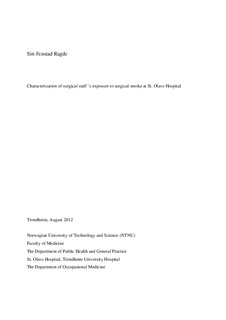Characterization of surgical staff `s exposure to surgical smoke at St. Olavs Hospital
Master thesis
Permanent lenke
http://hdl.handle.net/11250/264509Utgivelsesdato
2012Metadata
Vis full innførselSamlinger
Sammendrag
Introduction: Surgical smoke is produced when electrosurgery is applied to the patient`s tissue during surgical procedures. The smoke is known to contain numerous of volatile chemical compounds, and carcinogens have been identified. The smoke also contains ultrafine particles, which may propose a health hazard to the surgical staff in the operating room.
Methods: The aim of the study was to characterize the personal exposure of surgical smoke to the surgical personnel in the operating room, with emphasis on ultrafine particles. Five surgical procedures were selected to be included in the exposure assessment based on frequent use of electrosurgery and relatively short length of the procedures. Sampling of personal exposure to particles in surgical smoke in the range of 5.6-560 nm was performed using a Fast Mobility Particle Sizer, on four different job groups in the operating room. Important determinants of exposure were also investigated, using linear mixed effects models. In addition, three random samples of exposure to volatile organic compounds and aldehydes were executed on the main surgeon on three types of surgeries.
Results: Type of surgery was an important determinant of exposure to surgical smoke, and the use of electrosurgery resulted in exposure to mainly ultrafine particles. The exposure was highest during abdominoplasty and the lowest during hip replacement surgeries. A total of five VOC`s was identified and quantified. One sample contained low levels of formaldehyde. For the other samples, the levels were below the detection limit.
Conclusion: The use of electrosurgery resulted in short term high peak exposures to mainly ultrafine particles in surgical smoke. The job groups closest to the emissions are usually the highest exposed. Compared to other working environments the exposure levels for ultrafine particles was low. The concentrations of VOC`s and aldehydes was below the Norwegian OEL.
